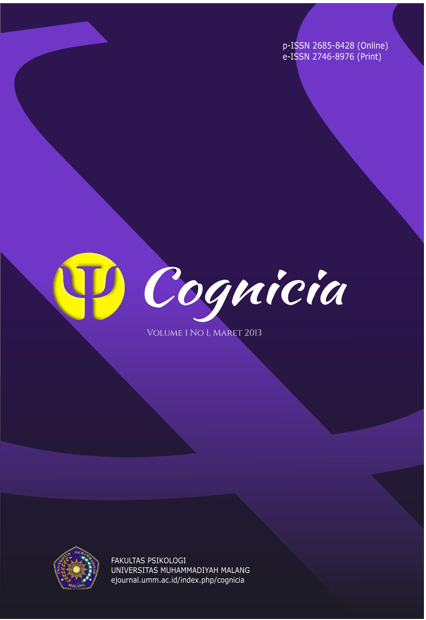SELF CONCEPT DENGAN ADVERSITY QUOTIENT PADA KEPALA KELUARGA DIFABEL TUNA DAKSA
DOI:
https://doi.org/10.22219/cognicia.v1i1.1445Abstract
Penelitian ini bertujuan untuk mengetahui hubungan self concept dengan adversity quotient pada kepala keluarga difabel tuna daksa di Kabupaten Jombang. Metode penelitian adalah kuantitatif korelasional.Subyek penelitian adalah kepala keluarga difabel tuna daksa yang sekaligus menjadi anggota Ikatan Penyandang Cacat (IPC) Jombang.Teknik pengambilan sampel menggunakan teknik purposive sampling, subjek penelitian berjumlah 30 orang, 21 laki-laki dan 9 perempuan.Metode pengumpulan data menggunakan skala self concept dan skala adversity quotient, skala tersebut menggunakan uji validitas product moment dengan realibilitas item pada skala self concept 0,940 sedangkan pada skala adversity quotient 0,965. Teknik analisa data menggunakan t-test, dimana diperoleh (r=0,516) dan (p=0,01).Hasil analisa data menunjukkan koefisien determinan variabel (r2) sebesar 26% yang artinya self concept memberikan sumbangan efektif terhadap adversity quotient sebesar 26%.Dengan demikian, hal ini menunjukkan bahwa terdapat hubungan yang signifikan antara self concept dan adversity quotient pada kepala keluarga difabel tuna daksa dimana kedua variabel tersebut berhubungan kuat dan berkorelasi positif.
Kata kunci: Self concept, Adversity quotient, Kepala keluarga difabel tuna daksa
The aimed of this research to find out relations between self concept with adversity quotient to person with disabilities as family head in Jombang Regency. Research method used is correlational quantitative method. Subject is person with disabilities as family head who also a member of Ikatan Penyandang Cacat (People with Disabilities Institution - IPC) Jombang. Sampling technique used purposive sampling. Research subject consisted of 30 people, 21 male and 9 female. Data collection method uses self concept scale and adversity quotient. The scale applied product moment validity test with item reliability in scale concept scale 0,940 while in adversity quotient 0.965. data analysis uses t-test where they found (r=0,516) and (p=0,01).Data analysis, it shows that variable determinant coefficient (r2) for 26% which means self concept give effective contribution to adversity quotient for 26 %. So, it shows that there’s significant relation between self concept and adversity quotient in person with disabilities as family head where both variables have strong relation and positive correlation.
Keywords: Self concept, Adversity quotient, Person with disabilities as family head
Downloads
Downloads
Published
How to Cite
Issue
Section
License
Copyright (c) 1970 Annisa Fitriana

This work is licensed under a Creative Commons Attribution-ShareAlike 4.0 International License.
Authors who publish with Jurnal Cognicia agree to the following terms:
- For all articles published in Jurnal Cognicia, copyright is retained by the authors. Authors give permission to the publisher to announce the work with conditions. When the manuscript is accepted for publication, the authors agree to automatic transfer of the publishing right to the publisher.
- Authors retain copyright and grant the journal right of first publication with the work simultaneously licensed under a Creative Commons Attribution-ShareAlike 4.0 International License that allows others to share the work with an acknowledgment of the work's authorship and initial publication in this journal.
- Authors are able to enter into separate, additional contractual arrangements for the non-exclusive distribution of the journal's published version of the work (e.g., post it to an institutional repository or publish it in a book), with an acknowledgment of its initial publication in this journal.
- Authors are permitted and encouraged to post their work online (e.g., in institutional repositories or on their website) prior to and during the submission process, as it can lead to productive exchanges, as well as earlier and greater citation of published wor (See The Effect of Open Access).

This work is licensed under a Creative Commons Attribution-ShareAlike 4.0 International License







